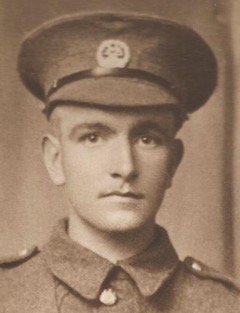Pte
Henry Reginald Hopkins
Information about birth
|
Date of birth: 13/03/1894 |
|
Place of birth: Dummer, Hampshire, England, United Kingdom |
General information
|
Last known residence: Flower Cottage, Preston Candover, Hampshire, England, United Kingdom |
|
Profession: Carter |
Army information
|
Country: England, United Kingdom |
|
Force: British Expeditionary Force |
|
Rank: Private |
|
Service number: 27469 |
|
Enlistment place: Basingstoke, Hampshire, England, United Kingdom |
|
Units: — Hampshire Regiment, 14th Bn. (Last known unit) |
Information about death
|
Date of death: 01/08/1917 |
|
Place of death: Alberta Farm, Sint-Juliaan, Belgium |
|
Cause of death: Killed in action (K.I.A.) |
|
Age: 23 |
Cemetery
|
Buffs Road Cemetery Plot: / Row: D Grave: 43 |
Distinctions and medals 2
|
British War Medal Medal |
|
Victory Medal Medal |
Points of interest 4
| #1 | Place of birth | ||
| #2 | Last known residence | ||
| #3 | Enlistment place | ||
| #4 | Place of death (approximate) |
My story
Henry Reginald Hopkins was born on 13 March 1894 in Dummer, near Basingstoke in Hampshire. He grew up with his mother Ellen, his stepfather Arthur Kimber and his stepsisters and brother in neighbouring Preston Candover. He worked as a carter on a farm. In Basingstoke, he enlisted in the British Expeditionary Force. Henry was assigned to the 14th Battalion Hampshire Regiment, part of the 116th Brigade of the 39th Division.
After fighting at Arras, the division returned to Flanders where some battalions took part in the Battle of Messines. The 14th remained in reserve. On 29 July 1917, the 14th Battalion moved to the Canal Bank at Ypres to take up its position the following evening for the attack that would mark the beginning of the Battle of Passchendaele. The 14th Hampshires were in support of the 11th Sussex Regiment, with the 13th Sussex Regiment on the right and the 17th Sherwood Foresters on the left at Hill Top Farm near Wieltje. The 116th and 117th Brigades aimed to cross the Steenbeek. The 118th Brigade was to take St Julien. The hour zero was at 03h50 on 31 July 1917. The German front line was quickly taken, but once the troops were swallowed by no-man's land, scattered 'pill-boxes' in the path of the 14th Battalion caused much trouble. The German machine guns were concealed and caused many casualties, resulting in delay and disorganisation. Especially around Alberta, just beyond the first fortified German defence line, the Albrecht-Stellung, the troops encountered fierce resistance. Only with the help of 2 tanks was the obstacle overcome. The ruins of St Julien were briefly taken by the 118th Brigade, but were soon abandoned due to increasing German pressure. The 14th Hampshires were able to dig in east of the Steenbeek. In the following days, however, the Battalion was heavily shelled; only outposts across the Steenbeek were retained. On the morning of 3 August, the battered battalion was relieved and withdrawn to the canal bank.
Henry Reginald Hopkins, aged 23, died on 1 August 1917. He was buried directly in Buffs Road Cemetery, Row D, Grave 43.
After fighting at Arras, the division returned to Flanders where some battalions took part in the Battle of Messines. The 14th remained in reserve. On 29 July 1917, the 14th Battalion moved to the Canal Bank at Ypres to take up its position the following evening for the attack that would mark the beginning of the Battle of Passchendaele. The 14th Hampshires were in support of the 11th Sussex Regiment, with the 13th Sussex Regiment on the right and the 17th Sherwood Foresters on the left at Hill Top Farm near Wieltje. The 116th and 117th Brigades aimed to cross the Steenbeek. The 118th Brigade was to take St Julien. The hour zero was at 03h50 on 31 July 1917. The German front line was quickly taken, but once the troops were swallowed by no-man's land, scattered 'pill-boxes' in the path of the 14th Battalion caused much trouble. The German machine guns were concealed and caused many casualties, resulting in delay and disorganisation. Especially around Alberta, just beyond the first fortified German defence line, the Albrecht-Stellung, the troops encountered fierce resistance. Only with the help of 2 tanks was the obstacle overcome. The ruins of St Julien were briefly taken by the 118th Brigade, but were soon abandoned due to increasing German pressure. The 14th Hampshires were able to dig in east of the Steenbeek. In the following days, however, the Battalion was heavily shelled; only outposts across the Steenbeek were retained. On the morning of 3 August, the battered battalion was relieved and withdrawn to the canal bank.
Henry Reginald Hopkins, aged 23, died on 1 August 1917. He was buried directly in Buffs Road Cemetery, Row D, Grave 43.
Sources 7
|
14 Battalion Hampshire Regiment (The National Archives, KEW (TNA) , WO 95/2583/6). https://www.nationalarchives.gov.uk/ Sources used |
|
Atkinson C.T., The Royal Hampshire Regiment, Vol II 1914-1918, (Glasgow, Robert Maclehose & Company Ltd. , The University Press,1952), 228-231. Sources used |
|
British Army World War I Medal Rolls Index Cards, 1914-1920 (The National Archives, Kew (TNA), WO 372). https://www.nationalarchives.gov.uk/ Sources used |
|
Census Returns of England and Wales, 1901 (The National Archives, Kew (TNA), RG13). https://www.nationalarchives.gov.uk/ Sources used |
|
Census Returns of England and Wales, 1911 (The National Archives, Kew (TNA), RG14). https://www.nationalarchives.gov.uk/ Sources used |
|
McCarthy Chris., Passchendaele. The Day-by-Day Account (London, Unicorn Publishing Group, 2018), 29-30. Sources used |
|
UK, World War I Service Medal and Awards Rolls, 1914-1920(The National Archives, Kew (TNA), WO 329). https://www.nationalarchives.gov.uk/ Sources used |
More information 3
|
Commonwealth War Graves Commission Database https://www.cwgc.org/find-records/find-war-dead/casualty-details/451641 |
|
Lives of the First World War (Imperial War Museum) https://livesofthefirstworldwar.iwm.org.uk/lifestory/2546230 |
|
Namenlijst (In Flanders Fields Museum) https://namenlijst.org/publicsearch/#/person/_id=2c1a6122-6915-47dc-9b40-007831960d0a |
